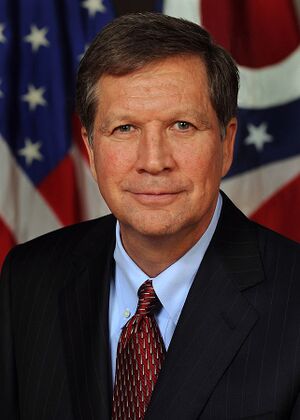Difference between revisions of "John Kasich"
(unstub) |
m (career update) |
||
| Line 19: | Line 19: | ||
|title=Governor of Ohio | |title=Governor of Ohio | ||
|start=January 10, 2011 | |start=January 10, 2011 | ||
| − | |end= | + | |end=January 14, 2019 |
}}{{job | }}{{job | ||
|title=Chairman of the House Budget Committee | |title=Chairman of the House Budget Committee | ||
| Line 62: | Line 62: | ||
==References== | ==References== | ||
{{reflist}} | {{reflist}} | ||
| + | {{PageCredit | ||
| + | |site=Wikipedia | ||
| + | |date=02.02.2022 | ||
| + | |url=https://en.wikipedia.org/wiki/John_Kasich | ||
| + | }} | ||
Revision as of 23:39, 24 February 2022
(politician) | ||||||||
|---|---|---|---|---|---|---|---|---|
 | ||||||||
| Born | John Richard Kasich 1952-05-13 McKees Rocks, Pennsylvania, U.S. | |||||||
| Alma mater | Ohio State University | |||||||
| Children | • Emma • Reese | |||||||
| Spouse | Mary Lee Griffith\ | |||||||
| Party | Republican | |||||||
US Republican politician who supported Biden over Trump
| ||||||||
John Richard Kasich Jr. [1][2] is an American politician, author, and television news host who served in the U.S. House of Representatives from 1983 to 2001 and as the 69th Governor of Ohio from 2011 to 2019. A Republican, Kasich unsuccessfully sought his party's presidential nomination in 2000 and 2016.[3]
Kasich grew up in McKees Rocks, Pennsylvania, moving to Ohio to attend college. After a single term in the Ohio Senate, he served nine terms as a member of the United States House of Representatives from Ohio.[4] His tenure in the House included 18 years on the House Armed Services Committee and six years as chairman of the House Budget Committee. Kasich was a key figure in the passage of both 1996 welfare reform legislation and the Balanced Budget Act of 1997. Kasich decided not to run for re-election in 2000 and ran for president instead. He withdrew from the race before the Republican primaries.
After leaving Congress, Kasich hosted Heartland with John Kasich on Fox News from 2001 to 2007 and served as managing director of the Lehman Brothers office in Columbus, Ohio.[5][6] He ran for governor of Ohio in 2010, defeating Democratic incumbent Ted Strickland.[7] He was re-elected in 2014, defeating Democratic challenger Ed FitzGerald by 30 percentage points. Kasich was term-limited and could not seek a third gubernatorial term in 2018; he was succeeded by fellow Republican Mike DeWine.
Kasich ran for president again in 2016, finishing in third place in the Republican primaries behind Donald Trump and Ted Cruz. He won the primary in his home state of Ohio and finished second in New Hampshire. Kasich declined to support Trump as the Republican presidential nominee and did not attend the 2016 Republican National Convention, which was held in Ohio.[8][9] In 2019, following the end of his second term as governor, Kasich joined CNN as a contributor.
Kasich is known as one of Trump's most prominent critics within the Republican Party,[10] and he endorsed Democratic presidential nominee Joe Biden for president in a speech at the 2020 Democratic National Convention.[11]
Executive at Lehman Brothers in Lead-Up to 2008 Crisis
According to CNN, "Kasich joined Lehman's investment banking division as managing director in 2001, working there until the firm's collapse in September 2008 unleashed global panic and served as the catalyst for the financial crisis." Kasich's past work at "arguably the most deeply vilified Wall Street firm," as CNN notes, "is likely to serve as rich fodder for political attacks" in the 2016 election cycle.
In addition to engaging in risky derivatives trading including credit default swaps, Lehman Brothers experienced unprecedented losses in the mortgage crisis. Lehman held on to large positions in subprime and other lower-rated mortgage tranches while securitizing the underlying mortgages leading to huge losses accrued in lower-rated mortgage-backed securities throughout 2008. In the second fiscal quarter, Lehman reported losses of $2.8 billion and was forced to sell off $6 billion in assets.[12] In the first half of 2008 alone, Lehman stock lost 73 percent of its value as the credit market continued to tighten. In August 2008, Lehman reported that it intended to release 6 percent of its work force, 1,500 people, just ahead of its third-quarter-reporting deadline in September.[12]
By September 2008, when Lehman Brothers declared bankruptcy, housing prices had already dropped 22 percent from the peak. Prices fell another 12 percent in the six months after Lehman collapsed.[13]
References
- ↑ https://www.washingtonpost.com/news/the-fix/wp/2015/07/21/its-pronounced-kay-sik-and-four-other-things-you-should-know-about-the-gops-16th-presidential-candidate/
- ↑ http://www.westervillelibrary.org/kasich/bio/
- ↑ https://web.archive.org/web/20170729233008/http://governor.ohio.gov/About/GovernorKasich.aspx%7Carchive-date=2017-07-29%7Curl-status=dead}}
- ↑ http://bioguide.congress.gov/scripts/biodisplay.pl?index=K000016
- ↑ https://abcnews.go.com/Politics/2010-election-wall-street-factor-ohio-governors-race/story?id=10586618
- ↑ http://www.daytondailynews.com/blogs/content/shared-gen/blogs/dayton/ohiopolitics/entries/2010/04/02/kasich_made_11_m_in_2008_no_go.html/
- ↑ https://www.sos.state.oh.us/sos/elections/Research/electResultsMain/2010results/20101102governor.aspx
- ↑ http://www.statesman.com/news/news/state-regional-govt-politics/john-kasich-not-following-ted-cruzs-lead-no-plans-/nsdq8/
- ↑ http://www.cleveland.com/politics/index.ssf/2016/10/john_kasich_follows_through_on.html
- ↑ https://www.businessinsider.com/john-kasich-response-trump-oval-office-address-2019-1
- ↑ https://www.foxnews.com/politics/john-kasich-conscience-democratic-convention-speech-biden
- ↑ a b Jenny Anderson and Eric Dash, "For Lehman, More Cuts and Anxiety," The New York Times, August 29, 2008.
- ↑ Edward L. Glaeser, "What We’ve Learned: Ugly Truths About Housing," New York Times, September 8, 2009.
Wikipedia is not affiliated with Wikispooks. Original page source here